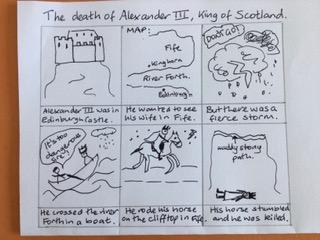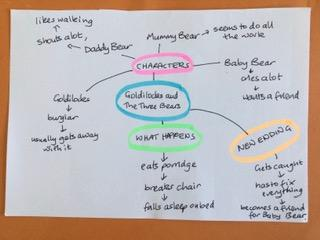You are here: Writing > Organising and Sequencing Writing
Children with dyslexia often have many creative ideas for the content of their writing but nonetheless have difficulty with
The following approaches can help support your child with writing.
Writing Frames:
These provide a structure for your child and help them write their story in a logical sequence. Below are two examples:
This first frame is useful for functional writing where your child is recalling what they did in a sequenced task and writing instructions.
This could be used for a recipe, an experiment, how to make a model or any form of instruction.
How To Make A _______________________________ by ______________________________
You will need: ...
First of all...
Then...
Next...
After that...
Lastly...
|
The second example supports writing a simple fiction narrative and the starter sentence cues can be changed to suit the required content of the storyline.
__________________________________________ by _____________________________________
Long, long, ago in the land of ________________________________________________________
there lived________________________________________________________________________
He had____________________________________________________________________________
One day___________________________________________________________________________
All of a sudden______________________________________________________________________
In a flash__________________________________________________________________________
And so_____________________________________________________________________________
Storyboards:
Drawing out a shortened version of the story can be a more achievable task that allows the child to recall or create their ideas in sequence and draw out their story/ideas.
Written details are added in the captions to each picture and can be expanded, using speech bubbles. This is a useful strategy that can be used for many scenarios, the example below relates to social subjects where the child has been asked to demonstrate their recount of a historical story with events in sequential order.

Storyboards can also be created using images/ photographs. For example, to recount a day trip or special event. Once photos are collected together, either physically or on a phone or device, they can be placed in the desired sequence and then used as an aid to help children recall what they wish to say, text can be added around the photos or written in a separate frame.
Ideas for the written text may be recorded to support the actual writing process, or possibly in place of writing.
Mindmaps:
Mindmaps are a good way to get ideas down on paper in note form and can be referred to and expanded on throughout the story.

Adapting an existing text:
This can be a good technique if your child struggles to find good ideas and finds the writing process tiring and intensive.
You could encourage your child to
-
retell a well known or favourite story
-
change the ending of a well-known story
-
change the behaviour of a well-known character
-
up-level basic sentences with more interesting vocbulary
For example:
You may think you know Cinderella is a kind, hard working sweet natured girl who'd do anything to help...
But one day she woke up in a bad mood and decided she'd had enougth of those sisters...
Or:
The dog barked. The man jumped. He ran away. This might be uplevelled to become...
When the fierce dog barked at the passing man he leapt in the air and shot off down the road.
All of the above supports can be used alone or in combination with each other, and technology can be used alongside as a memory support or to record ideas... check out our accessibility section.